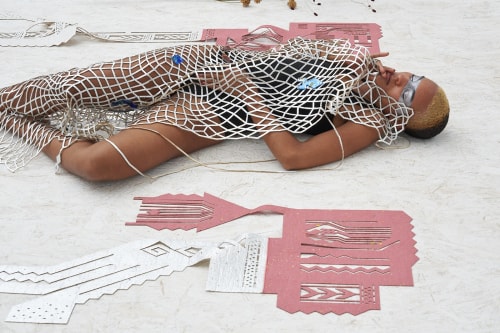How can we return to—or redefine—humanity’s place in our natural environment and the cosmos? What are the potentials for an ensouled world in light of its contemporary instability and complexity? In her exhibition “Still Shifting, Mother Field,” Jennifer Tee probes these fundamental questions about where we belong, about spirituality and transcendence. Her works—most of them created specifically for this presentation—are characterized by her experimental use of a wide variety of creative techniques. Tee combines collages and sculptures including ceramic domes, knitted floor objects, and textile coverings with performance art to uncover the fragile entanglements of life. Taking inspiration from the idea of the transmigration of the spirit or the lost soul, she puts a particular focus on forms of transition, the passages and processes of ongoing and incessant change.
The exhibition’s point of departure and framing element is the series of Tampan Tulips, which Tee has developed since 2016 and now presents for the first time in an extensive assembly. The motifs of the ten collages made of pressed tulip petals are based on tampan fabrics, ceremonial cloths from the region of Lampung in southern Sumatra, which was a hub for international trade routes for centuries, where they were exchanged in rates of passage. The ship is a central motif in the emblematic representations woven into the cloths, sailing toward another world with a company of humans, animals, and plantlike shapes. The geometric and often mirror-symmetric patterns visualize the orders of society as well as the universe and are seen as portals leading from the material to the spiritual world. This aspect is unmistakable, for example, in Tee’s most recent work, Tampan Sessile Beings, Sacred Shrine (2022), which features two ships facing each other at the top and bottom, with the top one also legible as a roof. At the center between them, a tree of life grows out of an ornament resembling a uterus, its crown symmetrically fanning out to meet the roots, so that the symbols for shelter, origin, and ancestry are tightly interwoven with those for departure, movement, and change.
By joining the Sumatran tradition of tampans to the tulip and its cultural history, Tee’s collages evoke a multiplicity of new narratives that refer to global networks and the exchanges and transfers of culture, nature, and commodities they power as well as to migration and intercultural identities. The combination of the two elements also ties in with Tee’s own biography: her Chinese-Indonesian ancestors arrived in the Netherlands in the 1950s, while her maternal grandfather was an exporter of tulip bulbs.
Native to the mountains of Central Asia and first cultivated in Persia and Turkey, the tulip has long been regarded as a symbol of love. In the Netherlands, many artists of the seventeenth century captured its beauty and impermanence in still lifes. During the tulip mania, the rare flower was seen as the ultimate status symbol. The trade routes forcibly opened up by the Dutch East India Company had produced an enormous accumulation of wealth and capital, setting the stage for the transformation of the widespread admiration for the tulip into greed and excessive speculation with flower bulbs that led to the first stock- market crash in 1637.
The artist carefully selects the petals for her collages. Some come from the so-called Rembrandt tulip, whose high-contrast striped pigmentation is caused by viruses. In a sensitive production process dependent on the seasons, she harvests the petals—for this stage, she cooperates with the Hortus Bulborum Foundation, which preserves historic cultivars of bulbous plants—and then dries and mounts them before translating the highly light-sensitive organic products into more durable prints.
Tee’s art is informed by her profound interest in states of transition into another world. In this connection, the artist herself speaks of a “soul in limbo” that is restless and alive, caught in an indeterminate place, a conceptual, mental, psychological, and physical space on the threshold between the here and the possible.
The Shrouds (2022) spread over low pedestals vaguely suggest the shape of a human body while portraying, as empty shells, the instant or process of its disappearance. The potential these coverings open up for body and soul is activated in weekly performances that Tee develops together with the choreographer Miri Lee. Five dancers interact with the textile sculptures. The suspended moment of falling asleep, the protection offered by a cocoon, and the metamorphosis of the snake shedding its skin are only some of the visual associations the performances will explore.
To make the Shrouds, Tee used a novel fabric composed of pineapple offcuts and recycled buffalo hide. The sculptures, like the floor works knitted from hand-dyed wool (Crystalline Floorpieces) and the ceramic objects, speak to a creative practice that integrates applied techniques into the work with compelling ease and deftly intertwines experimentation with the materials with philosophical reflections.
Another striking example of Tee’s quest for a spiritual dimension in art is the installation Tao Magic (2022) in the gallery’s apse. The ceramic domes gesture toward those cosmic orders and forces that, like the tides, are often invisible yet have a direct influence over our day-to-day lives. The arrangement suggests a constellation; the patterning of the glazes in various matt earth tones, meanwhile, recalls the shapes of full or half-moons. The work melds an expression of the idea in Taoist philosophy that the universe is creating itself afresh in a perpetual process with the Western tradition of grasping spirituality through abstraction, as observable in the oeuvres of Hilma af Klint and Wassily Kandinsky.
at Secession, Vienna
until November 6, 2022

